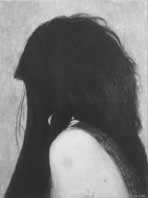 |
Christchurch in winter can be bitter with those cold-start mornings,
high blue skies, the white blankets of frost and the north easterly wind
which drifts across the city in cold gusts as the afternoon sun vanishes.
The city centre is losing its focus with the rise of the suburban malls
and parts of it look deserted-a network of avenues and bare branches,
sewn with lonely stores, peeling facades and empty offices. Massage parlours,
travel agencies and pool houses are the strongest street-signs while
the gentrification of the city boundaries intersperse the centre with
the high walls of 'no-access' and private lives. Cashel Street and Colombo
Street still seem like the retail centre but the grey anonymity of Cathedral
square is oddly set off by the green satellite squares of Cranmer, Latimer
and Victoria such that the heart of the inner city still seems like a
series of field-like clusters. What is the city centre though? A geographical
point, an intersection of supply and demand, a focus of activity, or
an imagined space? In the age of the simulacrum, the new millennium,
work for the dole, and no MTV, Christchurch has lost its existential
centre and we need to look to art for some solace and illumination. So
perhaps central Christchurch in winter with its spaces official, industrial,
retail, religious and private is represented in the blackly magical surfaces
of Tony de Lautour's New Paintings, the industrial-strength loneliness
of Seraphine Pick's Scratching Skin, and Ria Bancroft's moving Three
Decades of Sculpture, respectively shown at the Brooke-Gifford Gallery,
the Robert McDougall Art Annex, and the Robert McDougall main gallery.
Tony de Lautour's work has developed from the repetitive neo-impressionist emblematic
works of a few years ago to more iconographic and darkly Victorian representations
of a despoiled imperial landscape. Where de Lautour's motifs and symbols of 'white
trash' were worn by his canvases as tattoos, patches, seals, and scars, the recent
works have looked further at taxonomy and collection and offer an invocation
of corrupt officialdom and demonic display. The binary between heaven and hell,
innocence and experience is reinforced through a variety of emblems, motifs and
signatures all pointing to the darker rituals of the colonial malaise. Proud
and demonic lions, sick kiwis, worms, hypodermic needles, totems, stars, words
and bones are the symbols of Pakeha officialdom and abuse, the darkened eye of
post-imperialism scanning the web of its own corruption and decay. The library
of 'The British Book Club' and the comic guns made from cricket bats, the sick
kiwis and saws studded with the disks of chemically smiling stars are the stuff
of Boys' Own legend-this is the demonic distillation of 'white spirit'
etched on the canvas like the puff of the settler's musket, or like the drug-crazed
versions of an early poisoned Edenic nationalism.
Lonely spaces and existential anonymity are the signatures of Seraphine Pick's
retrospective Scratching Skin. Intimacy, solitude, denial, erasure, and
even immolation characterise Pick's works of abjection and emotional dilution.
Ghostly shopping bags, elongated and haunting hospital beds become the motifs
of emotional withdrawal, suffering, etiolation and bad sex. There are marked
shifts in style in this seriously girlie exhibition. Paintings which etch the
profile of movement, femininity and amnesia in an industrial context remind one
of the graffiti on the walls of an abandoned hospital or the permanent shadows
caught on the schoolroom blackboard. There is a buried angst in Pick's paintings
which explore the betrayals of intimacy and the emptiness of institutional detachment
through the veiled mythology of feminine consciousness. The archaeology of domesticity
and the persistence of memory, the lines and echoes of transience become an iconography
of shoe boxes, shopping bags, and rooms emptied of lives. The titles of the paintings
such as Why/Why Not?, Sound, and Looking Like Someone Else (portrait)
are the inscriptions of ambivalence, hesitation, and a chemistry of blurred thoughts
and lives, a dreamscape of trace and desire-the chord-of-life navel a reference
to an intimate knowledge of a perpetually anonymous subject. All in all, Pick's
work makes a peripatetic study of denial and disillusionment, and has anyone
noticed that her most recent paintings look like superb variations after the
cover of Radiohead's O.K. Computer?
 |
Seraphine Pick
Looking Like Someone Else #25
1997, Robert McDougall Art Annex |
Ria Bancroft's Three Decades of Sculpture was a show of some beauty. If
there is an artist who verges on a New Zealand Giacometti and the sublime, it
is Ria Bancroft. Her religious iconography was a highlight of the Christchurch
winter. The exhibition catalogue and space didn't do her justice. Horizon somehow
anticipates the new millennium and Mary, Mother of Jesus and Angel
of St. Matthew have the capacity to move and inspire even those who cannot
lay claim to Bancroft's deep Catholicism. The bronze Tabernacle Screen Doors installed
at the Cathedral of the Blessed Sacrament are elegiac, both humble and sophisticated,
and the Cathedral and Bancroft's sculpture are indicative of art, religion and
architecture working in harmony, symbiotically accentuating each other's simplicity
and beauty. What is different about these works is that although commissioned,
there is no ethos of 'sell' behind them. They are there to 'move' and be contemplated,
rather than the signatures of a transaction. In the age of transience, surficiality
and irony they are not cynical and this makes them valuable.
Luke Strongman
Spring 1998
|
 |